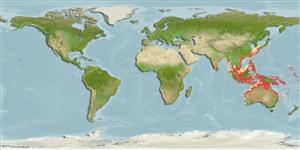Common names from other countries
Classification / Names / Names
俗名 | 同种异名 | Catalog of Fishes (gen., sp.) | ITIS | CoL | WoRMS
Environment: milieu / climate zone / depth range / distribution range
生态学
; 深度上下限 0 - 90 m (Ref. 81020).
分布
国家 | FAO区域 | 生态系 | 标本纪录 | 简介
Indo-West Pacific: China to Solomon Islands and Australia.
Length at first maturity / 大小 / 重量 / 年龄
Maturity: Lm ? range ? - ? cm
Shape varies from oval to conical. Spines are short and thin, with those nearer the oral surface being broad and flat. Color varies from white to olive green. Spines are green with reddish-brown, purple, white, or green brands.
Maximum spine length: 1.5 cm.
Life cycle and mating behavior
成熟度 | 繁殖 | 产卵场 | 卵 | 孕卵数 | 仔鱼
Members of the class Echinoidea are gonochoric. Fertilization is external. Brooding is common, eggs are held either on the peristome, around the periproct or deep into the concavities on the petaloids. Life cycle: Embryos develop into planktotrophic larvae (echinoplateus) and live for several months before they sink to the bottom using their tube feet to adhere on the ground where they metamorphose into young urchins.
主要参考文献
参考文献 | 合作者 | 合作者
Schoppe, S. 2000. (Ref. 800)
世界自然保护联盟红皮书 (Ref. 130435: Version 2024-1)
Not Evaluated
Not Evaluated
对人类的威胁
人类利用
| FishSource |
工具
网络资源
Estimates based on models
Preferred temperature
(Ref.
115969): 24.5 - 29, mean 28.1 (based on 1412 cells).
价格分类
Unknown.
